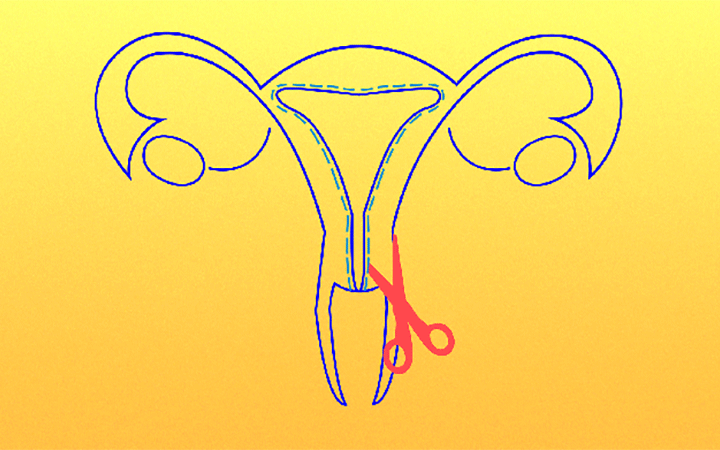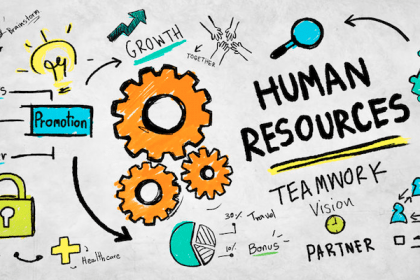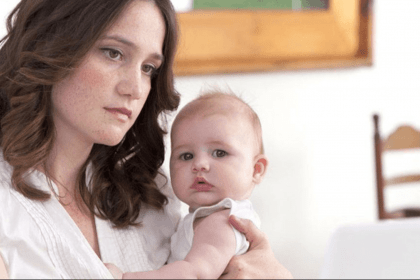by Tracy Collins Ortlieb Jun 03, 2019 at 2:30 pm EDT

On a summer Saturday, I lay on the living room floor, blithely watching cartoons in my pajamas. A bowl of dry Lucky Charms and a warm Sprite were meant to soothe a nagging stomach ache, and were failing.
My mother, walking past, ordered me into the bathroom. “There’s a spot on your pajama bottoms. I think you’re getting your period,” she whispered, a closed-door secret between us. I shimmied out of my stained bottoms, bright red blotches painting the lining of Disney-princess panties, a dozen readings of Are You There God? It’s Me, Margaret coalescing in one moment, the terrible ache in my now-throbbing gut.
Rifling through the cluttered vanity, she shoved a diaper-thick Kotex pad and two baby aspirin at me. “Congratulations,” she sighed. “You’re a woman now.”
I was 12. I loved bubble gum and horses and pretending to be a superhero on my bike. But I was a woman now, and being a woman meant enduring pain, every month, seemingly forever.
A family legacy
It was a pain my mother endured, and her mother before her, and one I inherited: monthly cramping that doubled me over, my insides pulsing torment, a bedridden girl with a heating pad and a bottle of my pain killer of choice. It was expected — it was the price to pay for sexual maturity — even if the occasional school day had to be missed, the odd pair of shorts soaked through to announce my fecund stain. The pain and humiliation was the embodiment of womanhood, a tradition passed down from my maternal ancestors like a Bible etched with a family tree, a secret we would each inherit but of which we’d never speak.
The one word altogether outside of our vocabulary: endometriosis. Becoming symptomatic at any time in a woman’s reproductive years, endometriosis takes place when tissue similar to the lining of the uterus (endometrium) attaches outside the uterus — the bladder, ovaries, fallopian tubes or elsewhere in the pelvis. The body reacts to this cellular irregularity with scarring, cysts, inflammation and discomfort. Affecting some 200 million women worldwide across all racial/ethnic and socioeconomic backgrounds, according to the Endometriosis Foundation of America, endometriosis remains largely unrecognizable, misdiagnosed and mistreated.
Had we broached it — among ourselves, with girlfriends, with medical professionals — we might have learned that our symptoms constituted more than just our monthly cycles: such early heavy bleeding and debilitating cramping are frequently markers of endometriosis, and early intervention can help most women avoid the typical seven-to-eight year journey to a confirmed diagnosis.
Researchers now believe that, in addition to familial inheritance, the most likely theory behind the disease is that endometrial cells are distributed throughout the pelvis as a mistake during prenatal development. The irregularity often making itself known as early as a girl’s first menarche.
Years later, an answer
As a teenager, I suffered silently, bowing out of pool days and staying off the tennis court to tend to bleeding and cramps one week a month, believing such symptoms to be a part-and-parcel transition from girlhood. It became ritualized: month-by-month, as the torment, bleeding, and additional symptoms increased, it was accepted, endured, normalized. It was only as a 20-year-old who first started investigating the sudden source of painful intercourse with my college boyfriend that led, six years later, to surgery revealing that an extensive case of endometriosis was to blame for years of prior pain.
Even then, my surgical OB-GYN urged me to have children, and soon. Endometriosis is a risk factor in infertility, and pregnancy stems the endometrial cells’ further growth. Still, no matter what steps I took, and despite the diseased cells she’d just excised, it would likely return. “Endometriosis can be contained,” my doctor to me, “but it has no cure.”
Decades later, a solution
In the coming years, endometriosis again edged into my life, announcing its presence in monthly aches, full-body bloating, staggeringly low energy. It was only when I became pregnant at 36 — and then again at 38 — that the symptoms temporarily abated. Following the birth of my second daughter, my OB-GYN discovered a new presence in my womb: a sizable uterine fibroid, a frequent comorbidity to symptomatic endometriosis.
Unsure then if I wanted additional children, I refrained from further surgeries to treat either condition, safeguarding my fertility. But as my children grew, so did the endometriosis and fibroid. Extensive monthly bleeding was now interrupted by mid-cycle “breakthrough bleeding” as the fibroid eventually grew to the size of a 4.5-month fetus. Tolerance was no longer a viable option. After a protracted discussion of options with my OB-GYN, the answer was transparent.
In December of last year, for my 50th birthday, I had a total hysterectomy. The six-hour procedure preserved my ovaries, allowing me to continue to absorb estrogen until menopause, but the extraction of the uterus, cervix and fallopian tubes ensured I would never again be plagued by endometriosis, comorbid fibroids or even the threat of reproductive-organ cancers.
It was a radical solution to a disease I’d tightroped between managing and enduring for some 30 years, the final coda to a constrictive, outdated version of womanhood. The surgery was life-changing, allowing me to again live without suffering, without worrisome distraction — the happy freedoms of a 12-year-old, finally returning to roost in now-healthy middle age.
This is a sponsored post.




